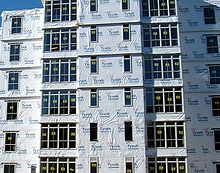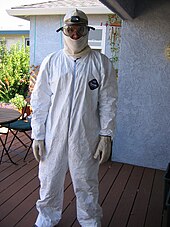Tyvek

Tyvek is a registered trademark of the company DuPont for a nonwoven fabric made of polyethylene high density (PE-HD), which is composed of fibrillated, closely connected to networks Feinstfilamenten builds microns in diameter range of 0.5 to 10 degrees. Through two different consolidation processes of the deposited fine fiber layers with calenders with smooth rollers or with engraved rollers, surface-bound products with a paper-like or film-like, somewhat stiffer character (type 10) for e.g. B. the packaging and office supplies industry or point-bound products with a textile, softer character (type 14) z. B. for protective clothing in clean rooms or as a base material for chemical-resistant coatings for the production of chemical protective suits. There is also a type 16, which is perforated with holes 0.13 and 0.51 mm in diameter, which leads to an even better textile character with increased air and moisture permeability. The different types are produced in different basis weights .
Manufacturing
Tyvek nonwovens are manufactured using flash spinning technology (evaporation spunbonding process), an exclusive process from DuPont. Development work for this began in 1955 and led to the first pilot plant in 1959 and finally to commercial production in 1967. Tyvek is produced in Richmond, Virginia / USA and Contern / Luxembourg. A DuPont packaging company is located in Shenzhen , China.
In this process, PE-HD is mixed with a solvent (e.g. methylene chloride) and heated under high pressure in an autoclave to high temperatures (25 ° C and more above the boiling point of the solvent). The mixed solution is then passed through nozzles under extremely precise control and relaxed in an explosive reaction. The solvent evaporates and a three-dimensional network of thin, fibrillated filaments in strand form is deposited by an oscillating depositing device on a depositing belt, which also serves as a conveyor belt. The result is an isotropic fiber arrangement, which has a positive effect on the tear strength. A minimum length of the fibrillated filaments of approx. 120 mm also contributes to increased strength values, as stated in one of the basic patents for this special nonwoven manufacturing process. As already mentioned, the fiber layers are consolidated with calenders of different types using heat and pressure. Further treatments such as an antistatic finish or pressure pretreatment using corona radiation can follow.
properties
In terms of its malleability, Tyvek behaves somewhat like paper, but is more durable. It is suitable as a material for protective clothing because, on the one hand, Tyvek itself only loses very few fibers and, on the other hand, thanks to the fleece, almost no cells separated from the body can escape from the suit. In this way, sterile working conditions, as required in the above-mentioned work areas, can be maintained.
recycling
Although the Tyvek Series 10 looks like paper, it is a plastic and cannot be recycled in the same way as paper. The company lists numerous reuse options on its website. It should be noted that Tyvek, which is used for protective suits, may be subject to special regulations for recycling, depending on the type of contamination.
States of production
The production takes place in:
- USA at the Richmond (Virginia) site
- Luxembourg at the Sandweiler - Contern site
A DuPont packaging company is located in Shenzhen, China.
use
- Protective clothing for clean areas or protection against pollution ( painting )
- Covers for cars, motorcycles and garden furniture to protect against snow and ice, environmental pollution, pollution from birds and trees.
- In the area of sports sponsorship, Tyvek was used for the advertising material " Drehbande ". a. at the games of the German national soccer team
- Packaging material for sterile items (sterilization bags for plasma sterilization )
- It is also used as a second roof skin due to the vapor diffusion openness and simultaneous watertightness .
- Due to its tear resistance, Tyvek is also often used for control and admission wristbands (party wristbands) at parties.
- CD / DVD cases or packaging material for sending the media by post. B. used for DVD rental service.
- Tyvek is suitable for building kites because it is easy to paint, glue and sew, and is weatherproof.
- Attempts around 1980 to use Tyvek for the production of plastic banknotes , however, have not found widespread use except in Haiti, Costa Rica and the Isle of Man.
- As Tyvek HomeWrap it is used as weather protection, especially in wooden houses, such as those built on the American continent. To the house is up on doors and windows almost wrapped (wrapped) . This means that water cannot penetrate, but water vapor (gaseous) that occurs inside diffuses to the outside.
- As packaging material for works of art, e.g. B. for transports at exhibitions or for storage.
- As a material for rain-resistant maps
- Women's handbags, money bags and laptop bags
- Books for babies and toddlers
Web links
- Website at DuPont ; accessed on October 2, 2019
- Tyvek on materialarchiv.ch, accessed on March 21, 2017.
Individual evidence
- ↑ Tyvek product manual (PDF; 388 kB), accessed on December 10, 2012.
- ↑ U.S. Patent 3,169,899 : Nonwoven fiberous sheet of continuous strand material and the method of making same. February 16, 1965.
- ^ Subhash K. Batra, Benham Pourdeyhimi: Introduction to Nonwovens Technology. DEStech Publications, Lancaster 2012, ISBN 978-1-60595-037-2 , p. 269 ff.
- ↑ Francis M. Buresh: Nonwoven Fabrics. Reinhold Publishing Corp., New York 1962, ISBN 978-1-85573-603-0 , p. 193.
- ^ Website of the Dupont company .

